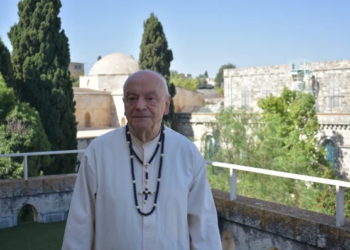The U.S. Air Force sent a Bomber Task Force to Japan as a sign that the United States “demonstrates, to both enemies and friends, the United States’ ability to project power anywhere in the world.”
As reported last week, at least two United States Air Force Rockwell B-1B Lancer long-range strategic bombers from the 9th Expeditionary Bomb Squadron, at Dyess Air Force Base (AFB), Texas, were deployed to Japan as part of the first rotational Bomber Task Force (BTF) mission to the island nation.
BTF 25-2 will likely last around six weeks.
During this time, the Cold War-era bombers will train alongside allies and regional partners to show the U.S. commitment to the Indo-Pacific. Air Force Global Strike Command – Air Forces Strategic-Air oversees the strategic air missions.
“BTF 25-2 showcases the U.S. commitment to deterring threats and maintaining regional stability,” said Lt. Col. Christopher Travelstead, 9th Expeditionary Bomb Squadron director of operations.
“These missions in the Indo-Pacific ensure our B-1B crews are highly trained and ready to respond anytime, anywhere, to defend U.S. interests and support our allies, securing a stable Indo-Pacific, where all nations operate freely under a rules-based order while promoting global peace and prosperity.”
The deployment of the B-1B bombers from Texas comes just weeks after four other Lancers returned to the United States after completing BTF 25-1.
The aircraft from the 28th Bomb Wing, Ellsworth AFB, South Dakota, arrived at Andersen AFB, Guam, in January and spent six weeks participating in joint exercises with regional allies and partners.
At least one B-1B Lancer deployed to the Indo-Pacific participated in joint air force drills in February with South Korean F-35 Lightning II and F-15 Eagle jets and U.S. F-16 Fighting Falcons. It marked the first exercises over the Korean Peninsula since President Donald Trump’s second term began.
Why Are the B-1B Lancers Going to Japan?
The U.S. Air Force has increased its BTF missions, but the deployment of the Lancers to Japan is notable, explained Colonel William Dunn, president of Strategic Resilience Group, LLC.
“The movement of military assets into and out of specific areas demonstrates, to both enemies and friends, the United States’ ability to project power anywhere in the world,” Dunn told The National Interest via an email.
“The BTF-25-2 mission is most likely aimed at demonstrating power projection to both North Korea and to China as well as to reassure our friend that the United States remains steadfast to ensure stability in the region as well as demonstrating our resolve in the event of a crisis,” Dunn added.
The B-1B Lancer’s Past Continuous Bomber Presence
Before the U.S. Air Force adopted BTFs, the Department of the Air Force maintained a Continuous Bomber Presence (CBP) in various allied and partner nations. The CBP strategy was first implemented in 2004, but it was discontinued in 2018 as the department moved to a “Dynamic Force Employment.”
That has been especially important in the Indo-Pacific, where China continues to rattle sabers and extend its influence, including in contested waters in the region. The deployment of B-1B Lancers, as well as the Boeing B-52 Stratofortress and Northrop B-2 Spirit bombers, is now conducted on a less predictable timeline.
“BTF missions are an outstanding way to send a strong message to both our friends and foes regarding the United States’ ability to project firepower in the region,” said Dunn.
The B-1B Lancers Will Be Replaced by the B-21 Raider
While the B-1B Lancer will probably remain a familiar sight in the Indo-Pacific throughout 2025 and 2026, by the end of the decade, it will begin to be replaced by the new Northrop Grumman B-21 Raider that begins the rotations.
While a total of 100 B-1B Lancers were produced, there are currently just forty-five in active service.
About the Author: Peter Suciu
Peter Suciu is a Michigan-based writer. He has contributed to more than four dozen magazines, newspapers, and websites with over 3,200 published pieces over a twenty-year career in journalism. He regularly writes about military hardware, firearms history, cybersecurity, politics, and international affairs. Peter is also a Contributing Writer for Forbes and Clearance Jobs. You can follow him on Twitter: @PeterSuciu. You can email the author: [email protected].
Image: Wikimedia Commons/ Staff Sgt. Peter Reft.

















